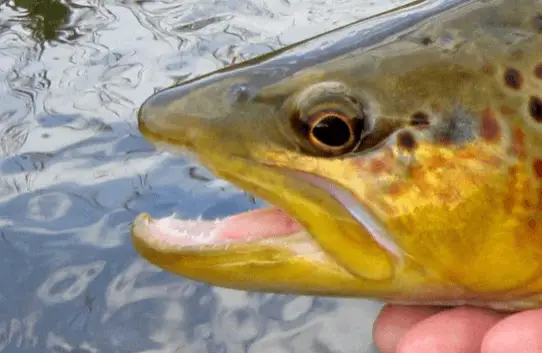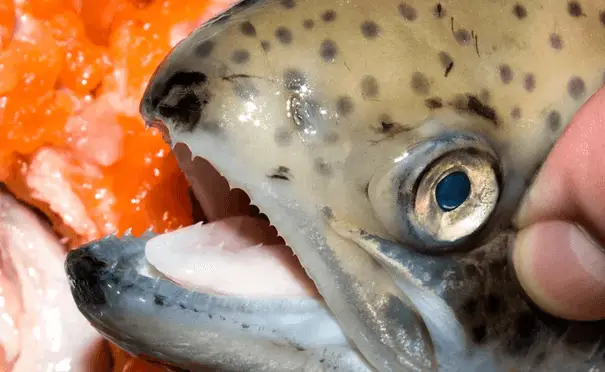Yes, trout do have teeth. Their teeth are small, sharp, and primarily located on the roof of their mouth on trout. In this artile we share about everything about of Trout teeth.
Trout are a popular species among anglers due to their widespread distribution and the challenge they pose when fished. With sleek bodies and a variety of species, these freshwater fish inhabit cool, clear streams, rivers, and lakes. Their teeth play a crucial role in their diet, helping them secure prey like insects, smaller fish, and crustaceans.
Understanding trout and their dentition is essential for those interested in trout fishing, as it impacts bait selection and handling. Anglers appreciate trout not only for their sportive qualities but also for their culinary value, making knowledge about these fish valuable for a successful outdoor adventure.
Do trout have teeth on their tongue
Trout do not have teeth on their tongues. Instead, they have small, fine teeth in their mouths, including along the roof of the mouth and on the tongue on trout. These teeth help trout grip and swallow their prey, which typically consists of small aquatic insects, and occasionally smaller fish. While the teeth on the tongue may not be as prominent as those along the jawline, they still play a role in assisting the trout in capturing and consuming their food.
What Makes Trout Different
They have specific characteristics setting them apart from other fish:
| Feature | Description |
| Teeth Positions | They can be found on multiple parts of the mouth, not just the jawline. |
| Retractable Lower Jaw | This unique trait allows for a powerful grip on prey. |
| Teeth Replacement | Trout can replace teeth, ensuring their feeding capabilities endure. |
Each trout species adapts its teeth to its diet and environment. Such adaptations ensure their survival and efficiency as predators in diverse aquatic realms.
Types Of Trout Teeth
- Villiform Teeth: These are fine, hair-like teeth found in the jaws of trout. Villiform teeth are numerous and are used for grasping and holding onto small prey such as insects and crustaceans.
- Canine Teeth: Some trout species, like rainbow trout, possess larger, pointed canine teeth near the front of their jaws. These teeth are sharper and serve to puncture and grip larger prey items, aiding in their capture.
- Pharyngeal Teeth: Located in the throat area on the pharyngeal bones, pharyngeal teeth are smaller and adapted for crushing and grinding food items before they are swallowed.
- Tongue Teeth: While not as prominent, some trout species may have small teeth on their tongues. These assist in manipulating and guiding food towards the throat for swallowing.
Location Of Teeth In Trout
Trout teeth aren’t where you might expect. The most prominent place you’ll find them is the roof of their mouth, also known as the vomerine area, and on their tongue.
| Teeth Type | Location |
| Vomerine Teeth | Roof of the mouth |
| Maxillary Teeth | Edge of the jaw |
| Mandibular Teeth | Lower jaw |
| Pharyngeal Teeth | Throat region |
The Purpose Of Teeth In Trout
Have you ever wondered about the sharp surprises hiding in a trout’s mouth? These aquatic hunters are more than what meets the eye. Understanding why they have teeth reveals much about their behavior and place in the freshwater ecosystem. Let’s dive into the intriguing roles their teeth play.
Feeding Habits
Trout teeth are not just for show. They serve a vital purpose in securing their menu of choice. From slippery insects to other fish, their teeth help them grip and tear their prey. Unlike humans, they cannot chew, so their teeth enable them to break down food into swallowable pieces. Here are some points on how their teeth aid in feeding:
- Grasp and hold slippery prey
- Break down food for easy swallowing
- Strip feathers or scales from their catch
Role In Self-defense
Teeth are not just for eating; they’re also a trout’s shield. In the wild, potential threats lurk around every riverbend. Teeth equip with a mechanism to fight off predators. When cornered or threatened, it’s can deliver a sharp nip to deter an aggressor. Their teeth serve as a protective tool, ensuring their survival against larger fish and other predators.
- Deterring predators with a bite
- Serving as a defense mechanism in the wild
- Protecting territory and spawning grounds
The Lifecycle Of Trout Teeth
Imagine a trout darting through a sparkling stream. Predatory and precise, they rely on a lesser-known feature: their teeth. Few anglers pause to ponder the intriguing lifecycle of teeth. This lifecycle is essential for their survival and hunting prowess. Let’s dive into the fascinating growth and development of these aquatic sharpshooters’ dental tools.
Growth And Development
As trout hatch from their eggs, they feature no teeth. Yet, these essentials for survival quickly start to form. Teeth begin to grow as the fry matures, crucial for catching prey.
Using list to show different stages
- Fry stage: Small, undeveloped teeth.
- Juvenile: Teeth become sharper as diet changes.
- Adult: Full set of strong, sharp teeth for hunting.
The trout’s teeth are shaped by their diet. They adapt to efficiently catch and consume different types of aquatic life.
Did you know? The diet of a they can influence how its teeth develop. Insect-heavy diets result in finer teeth, while those feasting on other fish grow pronounced, hooked teeth.
Shedding And Regrowth
Teeth shedding is a natural part of the trout’s lifecycle. Much like snakes shed their skin,& shed their teeth.
This remarkable process allows older or damaged teeth to be replaced. New, sharp teeth are essential for the trout’s continued ability to feed effectively.
| Age | Description | Frequency of Shedding |
| Juvenile | Initial shedding; small, fine teeth | High |
| Adult | Persistent regrowth; sharper, larger teeth | Varies based on health and diet |
Seasons also play a role in the frequency of teeth shedding. During spring and autumn, regrowth is common to prepare for varied diets.
Conclusion
Wrapping up, it’s clear that trout do indeed have teeth, an intriguing feature for avid anglers and curious minds alike. This quirky trait enhances their predatory abilities, ensuring survival in diverse habitats. Remember, handle these fish with care and respect their toothy grins during your fishing adventures.


